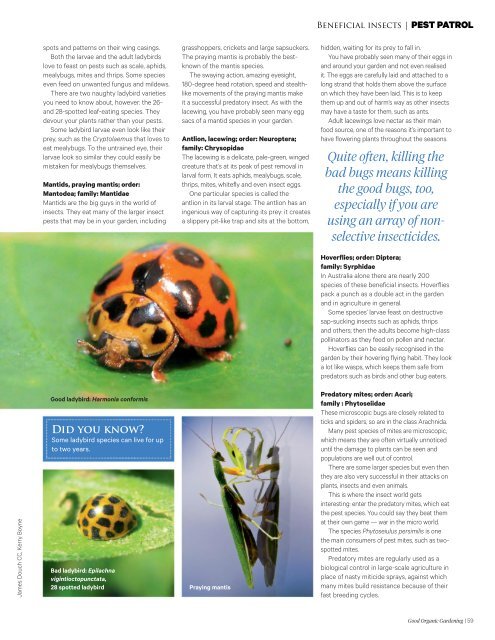5. Good Organic Gardening - September-October 2016 AvxHome.in
5. Good Organic Gardening - September-October 2016 AvxHome.in
5. Good Organic Gardening - September-October 2016 AvxHome.in
You also want an ePaper? Increase the reach of your titles
YUMPU automatically turns print PDFs into web optimized ePapers that Google loves.
Beneficial <strong>in</strong>sects | PEST PATROL<br />
spots and patterns on their w<strong>in</strong>g cas<strong>in</strong>gs.<br />
Both the larvae and the adult ladybirds<br />
love to feast on pests such as scale, aphids,<br />
mealybugs, mites and thrips. Some species<br />
even feed on unwanted fungus and mildews.<br />
There are two naughty ladybird varieties<br />
you need to know about, however: the 26-<br />
and 28-spotted leaf-eat<strong>in</strong>g species. They<br />
devour your plants rather than your pests.<br />
Some ladybird larvae even look like their<br />
prey, such as the Cryptolaemus that loves to<br />
eat mealybugs. To the untra<strong>in</strong>ed eye, their<br />
larvae look so similar they could easily be<br />
mistaken for mealybugs themselves.<br />
Mantids, pray<strong>in</strong>g mantis; order:<br />
Mantodea; family: Mantidae<br />
Mantids are the big guys <strong>in</strong> the world of<br />
<strong>in</strong>sects. They eat many of the larger <strong>in</strong>sect<br />
pests that may be <strong>in</strong> your garden, <strong>in</strong>clud<strong>in</strong>g<br />
grasshoppers, crickets and large sapsuckers.<br />
The pray<strong>in</strong>g mantis is probably the bestknown<br />
of the mantis species.<br />
The sway<strong>in</strong>g action, amaz<strong>in</strong>g eyesight,<br />
180-degree head rotation, speed and stealthlike<br />
movements of the pray<strong>in</strong>g mantis make<br />
it a successful predatory <strong>in</strong>sect. As with the<br />
lacew<strong>in</strong>g, you have probably seen many egg<br />
sacs of a mantid species <strong>in</strong> your garden.<br />
Antlion, lacew<strong>in</strong>g; order: Neuroptera;<br />
family: Chrysopidae<br />
The lacew<strong>in</strong>g is a delicate, pale-green, w<strong>in</strong>ged<br />
creature that’s at its peak of pest removal <strong>in</strong><br />
larval form. It eats aphids, mealybugs, scale,<br />
thrips, mites, whitefly and even <strong>in</strong>sect eggs.<br />
One particular species is called the<br />
antlion <strong>in</strong> its larval stage. The antlion has an<br />
<strong>in</strong>genious way of captur<strong>in</strong>g its prey: it creates<br />
a slippery pit-like trap and sits at the bottom,<br />
hidden, wait<strong>in</strong>g for its prey to fall <strong>in</strong>.<br />
You have probably seen many of their eggs <strong>in</strong><br />
and around your garden and not even realised<br />
it. The eggs are carefully laid and attached to a<br />
long strand that holds them above the surface<br />
on which they have been laid. This is to keep<br />
them up and out of harm’s way as other <strong>in</strong>sects<br />
may have a taste for them, such as ants.<br />
Adult lacew<strong>in</strong>gs love nectar as their ma<strong>in</strong><br />
food source, one of the reasons it’s important to<br />
have flower<strong>in</strong>g plants throughout the seasons.<br />
Quite often, kill<strong>in</strong>g the<br />
bad bugs means kill<strong>in</strong>g<br />
the good bugs, too,<br />
especially if you are<br />
us<strong>in</strong>g an array of nonselective<br />
<strong>in</strong>secticides.<br />
Hoverflies; order: Diptera;<br />
family: Syrphidae<br />
In Australia alone there are nearly 200<br />
species of these beneficial <strong>in</strong>sects. Hoverflies<br />
pack a punch as a double act <strong>in</strong> the garden<br />
and <strong>in</strong> agriculture <strong>in</strong> general.<br />
Some species’ larvae feast on destructive<br />
sap-suck<strong>in</strong>g <strong>in</strong>sects such as aphids, thrips<br />
and others; then the adults become high-class<br />
poll<strong>in</strong>ators as they feed on pollen and nectar.<br />
Hoverflies can be easily recognised <strong>in</strong> the<br />
garden by their hover<strong>in</strong>g fly<strong>in</strong>g habit. They look<br />
a lot like wasps, which keeps them safe from<br />
predators such as birds and other bug eaters.<br />
James Douch CC, Kerry Boyne<br />
<strong>Good</strong> ladybird: Harmonia conformis<br />
Did you know?<br />
Some ladybird species can live for up<br />
to two years.<br />
Bad ladybird: Epilachna<br />
vig<strong>in</strong>tioctopunctata,<br />
28 spotted ladybird Pray<strong>in</strong>g mantis<br />
Predatory mites; order: Acari;<br />
family : Phytoseiidae<br />
These microscopic bugs are closely related to<br />
ticks and spiders, so are <strong>in</strong> the class Arachnida.<br />
Many pest species of mites are microscopic,<br />
which means they are often virtually unnoticed<br />
until the damage to plants can be seen and<br />
populations are well out of control.<br />
There are some larger species but even then<br />
they are also very successful <strong>in</strong> their attacks on<br />
plants, <strong>in</strong>sects and even animals.<br />
This is where the <strong>in</strong>sect world gets<br />
<strong>in</strong>terest<strong>in</strong>g: enter the predatory mites, which eat<br />
the pest species. You could say they beat them<br />
at their own game — war <strong>in</strong> the micro world.<br />
The species Phytoseiulus persimilis is one<br />
the ma<strong>in</strong> consumers of pest mites, such as twospotted<br />
mites.<br />
Predatory mites are regularly used as a<br />
biological control <strong>in</strong> large-scale agriculture <strong>in</strong><br />
place of nasty miticide sprays, aga<strong>in</strong>st which<br />
many mites build resistance because of their<br />
fast breed<strong>in</strong>g cycles.<br />
<strong>Good</strong> <strong>Organic</strong> <strong>Garden<strong>in</strong>g</strong> | 59

















